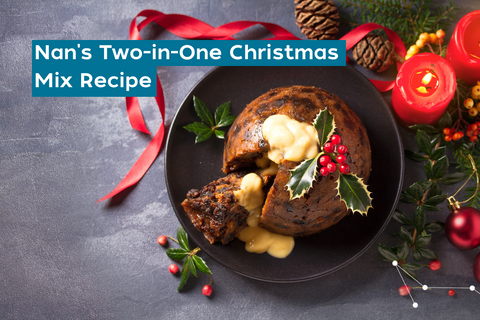This recipe will make a cake and a pudding, or two of either!
Ingredients:
- 375g butter
- 1 1/2 cups firmly packed brown sugar
- 1 cup water
- 1 cup brandy
- 3 cups (500g) raisins, chopped
- 3 cups (500g) sultanas
- 1 2/3 cups (250g) currants
- 1 1/3 cups (125g) chopped and pitted prunes
- 1 1/3 cups (125g) chopped and pitted dates
- 1/2 cup chopped glazed apricots
- 1/2 cup halved red glazed cherries
- 1 tbsp grated orange rind
- 2 tsp grated lemon rind
- 6 eggs lightly beaten
- 4 cups plain flour
- 1 tbsp mixed spice
- 2 tsp bicarb soda
Method:
1. Combine butter, sugar, water, brandy and fruit in a large saucepan. Stir overheat, without boiling, until sugar is dissolved and the butter is melted. Bring to the boil, the simmer, uncovered for 10 minutes.
2. Transfer mixture to a large heatproof bowl and cool to room temperature.
3. Line a deep 19cm square pan with 3 layers of baking paper. Grease a pudding steamer (8-cup capacity) and line with baking paper.
4. Stir rinds, eggs and sifted dry ingredients into fruit mixture. Divide mixture into 2 even portions.
5. To make the cake: Place 1 portion of the mixture into the prepared cake tin and peel out the surface. Bake slowly in a preheated oven on 140-150 degrees celsius for approximately 2 3/4 hours. Remove cake from the oven and cover tightly with aluminium foil and cool in its pan. Cake can be made and frozen for up to 6 months ahead of time or can be made 2 month in advance and stored in an airtight container.
6. To make a steamed pudding: Spoon the remaining portion of the mixture into a prepared steamer and cover with a large piece of aluminium foil. Ensure the lid is firmly on the steamer, then crush any excess foil firmly around the lid of the steamer to help form a good seal.
7. Please pudding in a large boiler with enough boiling water to come halfway up the side of the steamer. Cover the pan with a tight-fitting lid and boil for approximately 4 hours. Continuing to replenish the boiling water in the pan as necessary during the cooking time.
8. Remove the pudding from the boiler and cool to room temperature. The pudding can be kept in the steamer for up to 6 weeks in the refrigerator or removed from the steamer, wrapped in glad wrap and refrigerated or frozen.
9. To make a boiled pudding: Prepare a pudding cloth. Purchase 50cm of 122cm-wide unbleached calico; cut-in half, trimmed to give 2 square cloths (if you haven't got one already. Soak the cloth in cold water overnight.
10. The next day, boil the calico for 20 minutes then rinse. Dip the cloth into boiling water; using rubber gloves, wring any excess water from the cloth.
11. With 1/3 cup of plain flour, spread the hot cloth on. bench, quickly rubbing the flour into the cloth to cover an area about 38cm diameter, leaving flour thicker in the centre of the cloth where the 'skin' of the pudding will be the thickest.
12. Place cloth over a medium-sized bowl, placing the mixture in the centre using the bowl to stop the mixture from spreading. Gather the ends of the cloth, lift the pudding out of the bowl, patting in to shape with your hands.
13. Tie the pudding cloth securely with a string, as close to the pudding mixture as possible. Tying a loop in the string to make the pudding easier to lift rom the water.
14. Have a pot 3/4 full and rapidly boiling, gently and quickly place the pudding into he water and then quickly replace the lid, boiling rapidly for 6 hours. Ensuring to replenish the water throughout the 6 hours. You can also weigh the lid down to ensure it doesn't raise and allow any evaporation occur. There must be enough water in the pot to allow the pudding to float at all times. After 20-30 minutes the pudding will begin to float.
15. After 6 hours, use the handle of a wooden spoon to lift the pudding out of the water. Do not place the pudding down but rather suspend it from a cupboard handle or drawer while it cools to keep the shape intact. The pudding needs to be able to swing freely without touching anything.
16. If the pudding has been cooked correctly, the cloth with begin to dry out in patches within a few minutes. Leave pudding for 10 minutes, carefully peeling cloth back and then inverting the pudding onto a plate, allowing pudding to cool to room temperature.
17. Wash and dry the cloth, then re-wrap it around the pudding and try with a string, placing in an airtight plastic bad to refrigerate or freeze until required.


